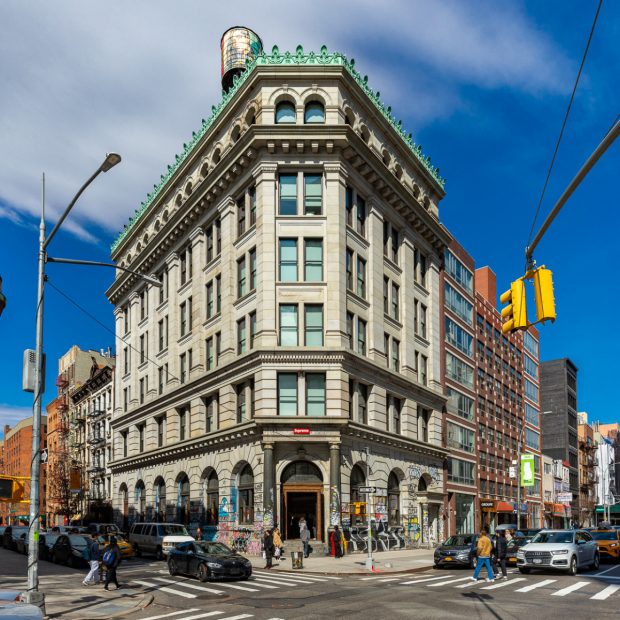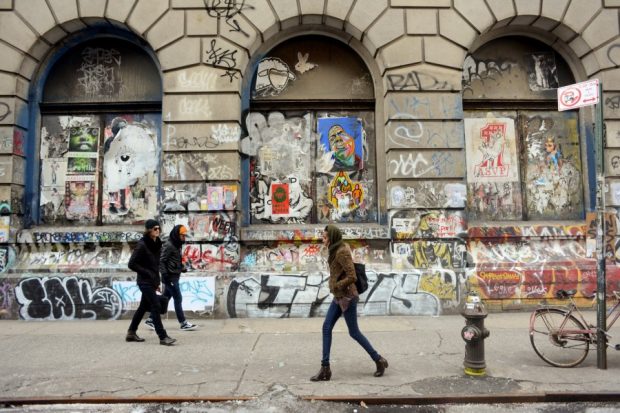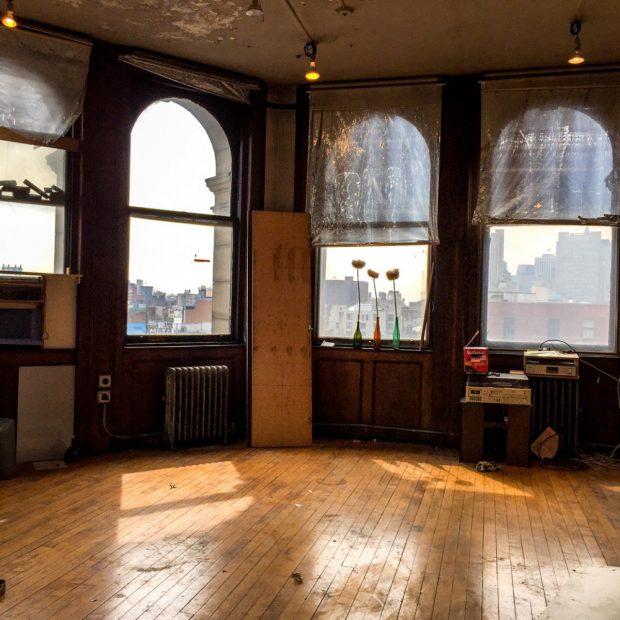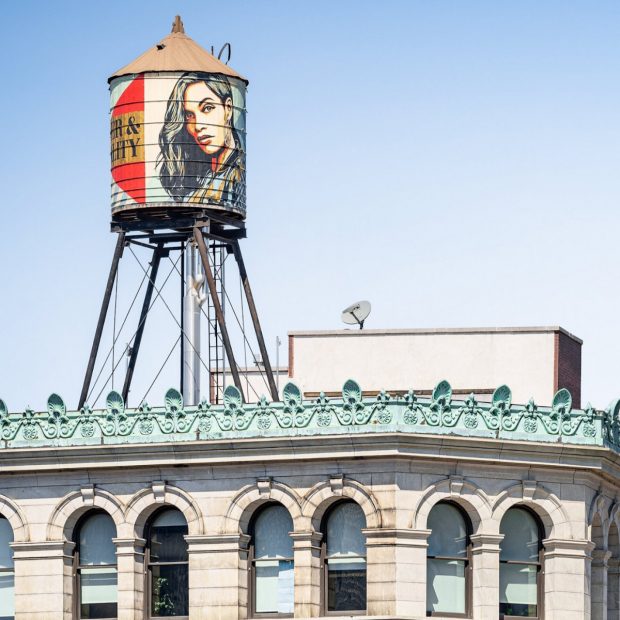
The house at 190 Bowery is located on the corner of Bowery and Spring Street in Manhattan’s trendy Nolita district – a building covered with graffiti. It was covered with old, partly sloping posters and the entrance was through a massive wooden door that was secured by an iron fence. Behind the building, which passers-by often cannot figure out, hides one of the most interesting stories in New York real estate history.

190 Bowery 9 years ago when it was still full of graffiti – photo Ed Jancick
In 1966 the photographer Jay Maisel and his wife Linda bought the then 68-year-old former bank building with 72 rooms on 6 floors for 102,000 dollars (today that would correspond to around three-quarters of a million). 190 Bowery had long been vacant by this time. The area around was considered one of the worst in Manhattan. At that time, the neighborhood did not have the pretty name Nolita, an acronym for “North of Little Italy”. The completely neglected entrance area was littered with garbage and covered with soot.
READ: The Bowery: The Street That Shows The Changes of New York
It was difficult to get the building clean and ready for a family to live in. While the building was bursting with dirt from decades ago, most of the structure was in excellent condition – a result of the high-quality construction. The oak parquet, the half-timbering, and the doors had aged in a beautiful way. Some of the walls were either originally pressed tin or with detailed, contemporary decorations. Several walls were covered with white tiles of the sort found in New York’s finest healthcare facilities around the turn of the 20th century. The small mosaic tiles that covered the floor of the vaulted cellar still looked like they had just been laid.

Inside view before renovation
The couple’s philosophy was to keep everything old as detailed as possible. The building’s original elevator – an elegant filigree copper box – was put back into operation, and the huge cast furnace returned to its original state. It’s in a large room on the sixth floor where the bank employees used to eat their meals. The former bank vault became a perfect storage location for Jay Maisel’s photo archive.
READ:222 Bowery: The Most Interesting Artist Commune in New York History
Of course, some things had to be redone. Because the building was built before air conditioning was invented, Maisel had to design an ingenious system of pipes that carry the air cooled by six different systems to each floor. The installation of a central air conditioning system, as it would have been the case nowadays in such a large building, would have destroyed some of the old building fabric and cost a fortune. The Maisels also took great care to place all innovations as “invisible” as possible.
The history of the building is closely related to that of the German immigrants in New York. The area around 190 Bowery was known as Little Germany around 1900. Here was the largest gathering of German immigrants and Americans of German origin in all of America. In keeping with this, the client was Germania Bank.
For bank operations and administration, she wanted a building in the Beaux Arts style, which was fashionable at the time. The bank then became an important contact point for thrifty immigrants or those who wanted to fulfill their dream of having their own house in the new world with a mortgage (many saw life in the narrow city only as a temporary solution and wanted to move out as soon as they are financially able). From the design by the architect Robert Maynicke to the construction company Marc Eidlitz & Son, everything remained in German-born hands. The construction budget was $ 200,000, an impressive sum for the time.
Since the 1970s, when graffiti and street art first appeared in New York, 190 Bowery was an ideal canvas for artists, as it was supposedly abandoned or at least had an owner who did not have the works removed again as quickly as possible. In the past, Maisel hired people to clean the facade every few years, but in later years he would leave the graffiti how and where it was. The result is an exciting contrast between the old, ghostly-looking building and modern street art.
READ: Vacation in Dubai: Is It Dangerous in Dubai
Only a few houses from Little Germany’s wedding survived. 190 Bowery is one of the most interesting as it also embodies the change in the city. It has seen many different people come and go, home or visit the city in each era – from German immigrants to graffiti artists to shoppers from all over the world shopping in the chic boutiques that it is today here there. In the more than 120 years that it has now stood on its corner, 190 Bowery has seen a lot of changes in New York – including real estate prices that shot into the astronomical.

Photography by Alexander Severin; Artwork – “Power & Equality” by Shepard Fairey, 2019
In 2015, when the real estate investor of German origin offered $ 55 million for the building, the then 84-year-old Maisel decided to sell 190 Bowery after almost 50 years. Rosen’s plan was not to change the outside of the building as much. When converting the rooms to retail, residential, and office space, characteristic building features should also be retained inside – of course only as long as they do not stand in the way of the marketability of the space. However, this strategy can definitely point to success. The young luxury clothing brand Totokaelo, which opened a large store on the ground floor in October 2017, is now using the old bank vaults as changing rooms.
Like us on Facebook for more stories like this: